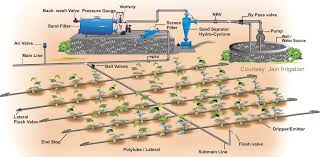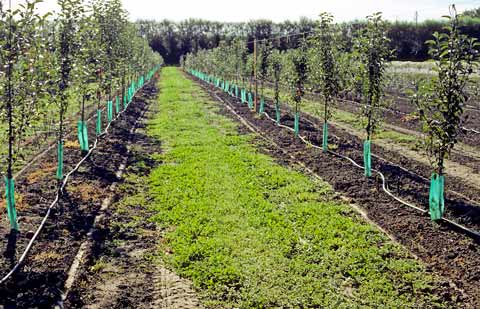 Delivering water to trees is essential to ensuring proper growth. It is also an expensive and time-consuming process. Many tree farmers are being forced, as a result of climate change, regulation, and simple economics, to rethink how they water their trees. Drip irrigation provides cost savings and a bevy of other benefits as well.
Delivering water to trees is essential to ensuring proper growth. It is also an expensive and time-consuming process. Many tree farmers are being forced, as a result of climate change, regulation, and simple economics, to rethink how they water their trees. Drip irrigation provides cost savings and a bevy of other benefits as well.
Water Savings
Open ditches allow water to evaporate quickly and sprinklers, while efficient in humid climates, can waste up to 45% of water when used in dry climates. Drip systems are the most efficient way to deliver water directly to plant roots and, as an added bonus, provide the most uniform watering of any system. Though buried systems are the most efficient, resulting in almost no water being lost, surface systems are still 85-90% efficient even in desert climates[1]. Drip irrigation systems, while somewhat more complex to install than other systems, are roughly as affordable in terms of upfront costs. Over time, drip irrigation can save farmers a great deal, both in taxes and in direct water costs, by reducing water use.
Better Yields
One argument made against drip irrigation is that it uses more water than conventional irrigation. This is true only in the crudest sense. Drip systems tend to use more water, overall, because the plants they supply are healthier and larger. The amount of water used per return (size, growth rate, yield), however, is much lower. With drip systems, farmers can have the same amount of growth with less water or they can achieve roughly twice as much growth (i.e. 100% more or 200% total) using just 15-20% more water.
rate, yield), however, is much lower. With drip systems, farmers can have the same amount of growth with less water or they can achieve roughly twice as much growth (i.e. 100% more or 200% total) using just 15-20% more water.
Disease
Drip irrigation systems spread less disease than sprinkler systems for two reasons. First, water that enters a drip system needs to be filtered to avoid clogs. Installing a filter that clears microorganisms as well as debris is not substantially more expensive than installing one that simply addresses debris. As a result of this minimal cost discrepancy, drip irrigation systems supply clean water than other systems.
Just as important as filtration, however, is water splash. Water splash is a primary means by which disease is transferred from plant debris and soil to other plants. Drip systems have zero splash and so reduce disease transmission dramatically.
Flexible
Drip systems, which allow for the use of emitters, can easily be customized to meet the needs of a diverse array of trees. Not only can the emitters by sized for individual plants, they can be swapped out if plants changed, the system is moved, or water-requirements fluctuate due to climate changes. Drip systems are also less vulnerable to damage by machines, which means farmers can be more flexible about where they place them.
Resources
[1] “Drip Irrigation for Trees – Forestry – forestry.usu.edu.” [Online]. Available: http://forestry.usu.edu/htm/city-and-town/tree-care/drip-irrigation/. [Accessed: 27-Aug-2015].

